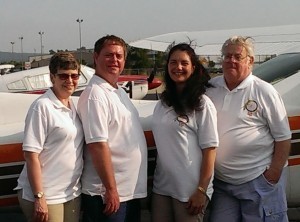Lisa Niver's Blog: We Said Go Travel, page 486
July 14, 2013
Italy: 51 over 11 under 4 in 182
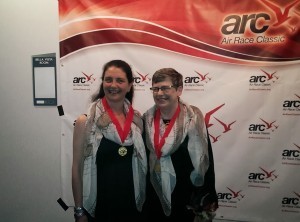 Turning 51 after flying over 11 states during the Air Race Classic under 4 days in a C182 R Skylane II
Turning 51 after flying over 11 states during the Air Race Classic under 4 days in a C182 R Skylane IIWhilst learning to fly in California at 38, I realized that not only age didn’t matter when following one’s dreams, but also that availability of information and access to role models did matter and had its importance and truly made the difference!
Returning to Italy after achieving my private, instrument and complex certificates, besides 200 hours of flight time, I noticed the lack of support and camaraderie on this side of the ocean. What did I do? I created AWE – Aviation and Women in Europe and went about collecting and disseminating information and creating opportunities for women who wish to enter aviation as a profession, in Europe and beyond.
How? Creating annual conferences, itinerant around Europe showcasing each country’s contribution and involvement in aviation through history and by being actively present during various events such as helping bring Women in Corporate Aviation to EBACE in Geneva and volunteering for Women in Aviation International and South African Women in Aerospace, being mentor for programs such as EAA’s KidVenture and Women Soar You Soar, and the Ninety-Nines Professional Pilot Leadership Initiative.
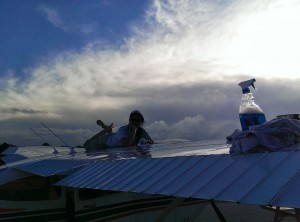 It is never too late to follow one’s dreams. I started flying at 38 and was a flight instructor, under European AND American rules, at the age of 45! My motto has become “Impossible is only a stepping stone to success” … which translates simply into not accepting NO as an answer.
It is never too late to follow one’s dreams. I started flying at 38 and was a flight instructor, under European AND American rules, at the age of 45! My motto has become “Impossible is only a stepping stone to success” … which translates simply into not accepting NO as an answer.
Currently I am out of an aviation job, but I am using this time to get my Bachelor of Science in Aeronautics. Over the years I have received recognition, scholarships, and awards for my achievements, mainly for my “uncommon determination in pursuing my goals and my potential to becoming an outstanding leader.” I am in my third year and expect to graduate in September 2005.
I wish to combine my 30+ years of business experience as an entrepreneur and my passion for flying and be accredited as an airport executive besides fly jets around the world. My plan is to fly helicopters at 85 and at 105 to write a book! In the meantime? To enjoy the view and the look in my mentees/students eyes when they “get it.”
This year I celebrated my 51st birthday participating in the Air race Classic, the all women’s cross country air race … and I came second! It all started in 2004 in New Zealand when I participated in the Round New Zealand Air Race. I met Chuck and Ed Frost and also Gretchen Jahn … fast forward and 9 years later here we are on the same team “The Dream Catchers.”
It most certainly was a challenge logistically for me in Italy, Gretchen in Denver area in the USA and the plane in Illinois. We managed it beautifully and the fact that Gretchen and I met in Wichita, Kansas to ferry the plane to Pasco , Washington gave us the time and opportunity to fly together, get to know each other and tweak our strengths and weaknesses!
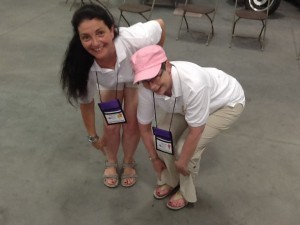 As part of the preparation for the race not only did we need to make sure the plane was airworthy, clean and polished but we also needed to make sure the pilots were at max as well. We had our manicure and pedicure before the race and even painted our toe nails racing red to fly faster! … We came in second overall!
As part of the preparation for the race not only did we need to make sure the plane was airworthy, clean and polished but we also needed to make sure the pilots were at max as well. We had our manicure and pedicure before the race and even painted our toe nails racing red to fly faster! … We came in second overall!
The race is about 2500 miles divided into nine legs that can be flown at any time deemed appropriate during the four day window available and only during the day time and in visual flight conditions. This year’s race took us through 11 states, starting in Washington state and ending in Arkansas.
During the race Gretchen and I looked after ourselves and each other, drinking enough water and eating good food, keeping ourselves hydrated and eating enough proteins … and sleeping well at night! The various challenges we met were overcome together, as a team. Communication was open and constant. We often even sang in the airplane, had fun, laughed and one afternoon we even had a massage.
Flying brings freedom of choice and opens many opportunities, whilst creating lasting friendships and learning to accept and at times even stretch one’s own personal limitations. And the view is spectacular!
About the Author: Michelle Bassanesi, Avid dream catcher, resource broker, and problem solver extraordinaire
The post Italy: 51 over 11 under 4 in 182 appeared first on We Said Go Travel.
July 13, 2013
Burundi: Finding Freedom in a War-Torn Country
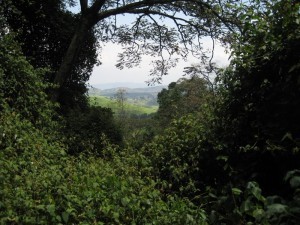 It’s odd to think of being free in a country that is still recovering from civil war. When comparing the highly developed, technological culture of the United States to the under-developed subsistence farming culture of Burundi, however, there is a kind of freedom. Freedom from returning emails because the Internet is down. Freedom from returning phone calls because the cell phone network is down. Freedom from work or social obligations because there’s a strike or roadblocks and you can’t drive across the city. We are free to sit on the porch and enjoy the beautiful view of the Congo mountains and Lake Tanganyika. When we lived in Bujumbura, Burundi, the civil war from the 1990s was technically still going on. The last rebel group signed a peace treaty shortly after our arrival in 2008. Many parts of the country were still unsafe to travel through as unemployed rebel fighters turned to armed robbery as a way to make a living. Gradually, however, more and more of the country became safe and we had the opportunity to visit some places that tourists and other outsiders had not seen in decades.
It’s odd to think of being free in a country that is still recovering from civil war. When comparing the highly developed, technological culture of the United States to the under-developed subsistence farming culture of Burundi, however, there is a kind of freedom. Freedom from returning emails because the Internet is down. Freedom from returning phone calls because the cell phone network is down. Freedom from work or social obligations because there’s a strike or roadblocks and you can’t drive across the city. We are free to sit on the porch and enjoy the beautiful view of the Congo mountains and Lake Tanganyika. When we lived in Bujumbura, Burundi, the civil war from the 1990s was technically still going on. The last rebel group signed a peace treaty shortly after our arrival in 2008. Many parts of the country were still unsafe to travel through as unemployed rebel fighters turned to armed robbery as a way to make a living. Gradually, however, more and more of the country became safe and we had the opportunity to visit some places that tourists and other outsiders had not seen in decades. 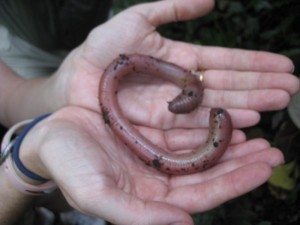 One of those places was Kibira forest. Patrice Faye, a French man who’d bicycled into Burundi decades ago and never left had become familiar with the forest and friendly with the Twa people who live there. The Twa let Faye bring tour groups through for hiking. Kibira forest was a rebel hiding ground during the war and in the years afterwards. Previously, up until the 1930s the forest had been the private hunting grounds for the kings of Burundi. After that the forest was conserved during German and Belgian colonial rule partly due to the mystical qualities Burundians had placed upon it. It is still one of the few undeveloped areas of Burundi, where wildlife runs free and cattle grazing and tea plantations are limited. A friend of ours knew Patrice Faye and so with my broken French I arranged for a hike through Kibira with some friends. I had no idea what was in store for us, not completely understanding everything he said. But we were ready for an adventure. We all met at the arranged time and started our drive from the flatland of Bujumbura north into the mountains.
One of those places was Kibira forest. Patrice Faye, a French man who’d bicycled into Burundi decades ago and never left had become familiar with the forest and friendly with the Twa people who live there. The Twa let Faye bring tour groups through for hiking. Kibira forest was a rebel hiding ground during the war and in the years afterwards. Previously, up until the 1930s the forest had been the private hunting grounds for the kings of Burundi. After that the forest was conserved during German and Belgian colonial rule partly due to the mystical qualities Burundians had placed upon it. It is still one of the few undeveloped areas of Burundi, where wildlife runs free and cattle grazing and tea plantations are limited. A friend of ours knew Patrice Faye and so with my broken French I arranged for a hike through Kibira with some friends. I had no idea what was in store for us, not completely understanding everything he said. But we were ready for an adventure. We all met at the arranged time and started our drive from the flatland of Bujumbura north into the mountains. 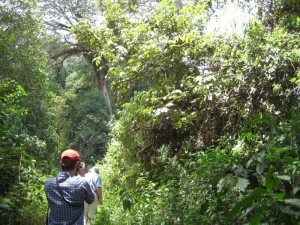 Some of the best tea and coffee in the world is grown in Burundi and after a couple hours of mountain driving, the tea plantation adjacent to Kibira came into view. We got out of the cars and had a quick lunch, then followed Patrice and his Twa guides into the tea. The plants were so thick and overgrown that even Patrice, who hikes in the area regularly, missed the path into the forest and the Twa led him back the correct way. Within a few minutes we were out of the tea and had entered forest canopy. The trees were large and ancient. It was like walking onto the set of Jurassic Park. The forest had a mystical feel to it and it was easy to understand why the Burundians had conserved it as a magical place. We would not have been surprised to see a brachiosaurus emerge from the greenery. The sounds of bugs, birds, and monkeys surrounded us. The forest is home to chimpanzees and colobus monkeys; unfortunately we didn’t see any that day. We did see giant, prehistoric-sized worms, slugs, and snails. We saw viper snakes, which Faye scooped up to take home with him. (He collects snakes to supply anti-venom to many of the hospitals in Bujumbura.)
Some of the best tea and coffee in the world is grown in Burundi and after a couple hours of mountain driving, the tea plantation adjacent to Kibira came into view. We got out of the cars and had a quick lunch, then followed Patrice and his Twa guides into the tea. The plants were so thick and overgrown that even Patrice, who hikes in the area regularly, missed the path into the forest and the Twa led him back the correct way. Within a few minutes we were out of the tea and had entered forest canopy. The trees were large and ancient. It was like walking onto the set of Jurassic Park. The forest had a mystical feel to it and it was easy to understand why the Burundians had conserved it as a magical place. We would not have been surprised to see a brachiosaurus emerge from the greenery. The sounds of bugs, birds, and monkeys surrounded us. The forest is home to chimpanzees and colobus monkeys; unfortunately we didn’t see any that day. We did see giant, prehistoric-sized worms, slugs, and snails. We saw viper snakes, which Faye scooped up to take home with him. (He collects snakes to supply anti-venom to many of the hospitals in Bujumbura.) 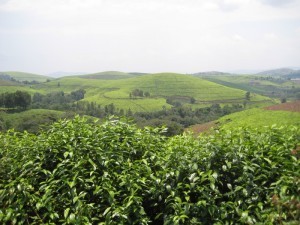 The location made this simple walk through the forest so special. We were walking through an area that few outsiders had visited even before the war. The forest, and Burundi in general, is not a place that many tourists think to go to; it doesn’t have the gorillas of neighboring Rwanda so it’s overlooked as a destination. Burundi is not well-developed but it is densely populated; the forest is one of the few unpopulated areas in the country. In the forest we felt free. Free from cell phones and televisions. Free from the traffic and pollution in the city. Tourists passing through meant economic freedom for the Twa, who, as the smallest ethnic group in the country, had been persecuted and chased away from much of the cultivatable farm and grazing land in other areas. Freedom meant different things to everyone on the walk that day. About the Author: Stephanie Smith Diamond is working on a memoir of her time in Burundi. She currently lives in Hyderabad, India, and is relocating to the United States this summer. She blogs at Where in the World Am I? Find her on Facebook. Photographs by Mike and Stephanie Diamond.
The location made this simple walk through the forest so special. We were walking through an area that few outsiders had visited even before the war. The forest, and Burundi in general, is not a place that many tourists think to go to; it doesn’t have the gorillas of neighboring Rwanda so it’s overlooked as a destination. Burundi is not well-developed but it is densely populated; the forest is one of the few unpopulated areas in the country. In the forest we felt free. Free from cell phones and televisions. Free from the traffic and pollution in the city. Tourists passing through meant economic freedom for the Twa, who, as the smallest ethnic group in the country, had been persecuted and chased away from much of the cultivatable farm and grazing land in other areas. Freedom meant different things to everyone on the walk that day. About the Author: Stephanie Smith Diamond is working on a memoir of her time in Burundi. She currently lives in Hyderabad, India, and is relocating to the United States this summer. She blogs at Where in the World Am I? Find her on Facebook. Photographs by Mike and Stephanie Diamond.
The post Burundi: Finding Freedom in a War-Torn Country appeared first on We Said Go Travel.
India: Trek For Milam Glacier
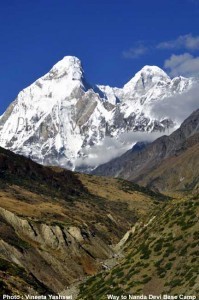 Trekking for Milam Glacier and Nanda Devi East Base Camp, India were my dream trek, which now come true.
Trekking for Milam Glacier and Nanda Devi East Base Camp, India were my dream trek, which now come true.One chilly morning I headed to Pithoragarh, which is a beautiful place where I spent night. Next morning I left to Munsyari. Route was blessed with lots of waterfalls, as the rain season just ended. 4 a.m. I reached Munsyari and met with my guide and crew.
Next morning I got golden view of Panchachuli. I went for a walk to enjoy morning view of Munsyari. Around 10 am, I start trekking. From Dhapa it was steep descend with rocky path. I walked till Jimigar, where I met River Gori. Now I had to follow the river. I crossed Jimigar through the bridge and took steep ascend for Lilam. Ascend become difficult because of blazing sun but I found beautiful waterfalls and caves. Trail was treacherous and Gori was flowing down. My little error could be through me into Gori. Around 2 p.m. I reached at Lilam (1850 mt.) pitched tent in a beautiful location and had lunch with local people. At night, after dinner, I retired to sleeping bag.
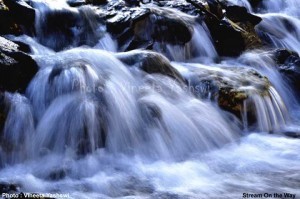 Next morning I headed towards Bogdiyar (2450 mt.). Big lizards were playing hide-n-seek here. This valley known as Johar Valley and people are traders and nomad. They migrate towards Munsyari in winter. Massive waterfalls were appearing on the trail and Gori following us with roaring voice and huge rapids. Though ascends were hard-hitting but I was astonished by the beauty of valley. I crossed bamboo jungle, caves and temples. In one temple, I saw snake’s fossils. Villagers pray here for safe journey. Around 1p.m., I reached Rangari village and then Garampani, which gets its name from hot water spring. I set here dipped foot into hot water. After refreshing break, I finished lunch at hotel. In these small hotels, you can get tea; food and space for night. It was dark when I reached Bogdiyar. Bogdiyar was cold but sky was shining with stars.
Next morning I headed towards Bogdiyar (2450 mt.). Big lizards were playing hide-n-seek here. This valley known as Johar Valley and people are traders and nomad. They migrate towards Munsyari in winter. Massive waterfalls were appearing on the trail and Gori following us with roaring voice and huge rapids. Though ascends were hard-hitting but I was astonished by the beauty of valley. I crossed bamboo jungle, caves and temples. In one temple, I saw snake’s fossils. Villagers pray here for safe journey. Around 1p.m., I reached Rangari village and then Garampani, which gets its name from hot water spring. I set here dipped foot into hot water. After refreshing break, I finished lunch at hotel. In these small hotels, you can get tea; food and space for night. It was dark when I reached Bogdiyar. Bogdiyar was cold but sky was shining with stars.
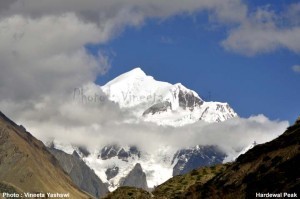 Next morning I left for Martoli (3430 mt.). In the start trail was easier but suddenly it became strenuous. Massive mountains, blue sky were enhancing the beauty. After steeper ascend I reached Laspa village. Now tree line had been vanished and Bugyal, huge meadows, appeared. I reached Rilkot village after 2 hours. It’s evening now and I was exhausted but still had to cross steeper ascend. When I reached Martoli it was dark. I roamed around. Broken houses were giving ghostly feeling and it was chilly also. Two men came and gave me place to pitch tent.
Next morning I left for Martoli (3430 mt.). In the start trail was easier but suddenly it became strenuous. Massive mountains, blue sky were enhancing the beauty. After steeper ascend I reached Laspa village. Now tree line had been vanished and Bugyal, huge meadows, appeared. I reached Rilkot village after 2 hours. It’s evening now and I was exhausted but still had to cross steeper ascend. When I reached Martoli it was dark. I roamed around. Broken houses were giving ghostly feeling and it was chilly also. Two men came and gave me place to pitch tent.
Morning it was frost all over. I went towards Nanda Devi temple and village. Martoli situated on the Indo Tibetan trade route, which has closed since 1962. Now most houses have been broken. Traditional architect of the houses attracted me a lot. After this walk, I headed towards Ganghar.
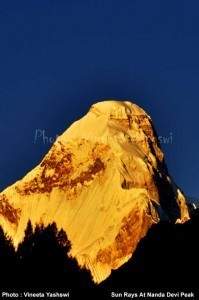 I took treacherous descend for Ganghar (3328 mt.). I crossed Burfu village. Except one steeper ascend the trail was easy but winds were blowing fast. When I reached Ganghar, ladies started dance holding mobile. Here I made base camp for Milam Glacier and Nanda Devi East Base Camp.
I took treacherous descend for Ganghar (3328 mt.). I crossed Burfu village. Except one steeper ascend the trail was easy but winds were blowing fast. When I reached Ganghar, ladies started dance holding mobile. Here I made base camp for Milam Glacier and Nanda Devi East Base Camp.
Next day, I headed towards Milam Glacier (3500 mt.). After crossing Pachhu village I saw confluence of Gwankh River, which comes from Tibet and Gori River. Through the makeshift bridge, I crossed Gori. One strenuous climb made me exhausted but when I saw Hardeol Peak I felt relief. After little trek I saw Glacier but wanted to see it close so moved on. Trail was nowhere. I was making way through the pile of stones. Place was like natural stone crasher. After crossing rocky way, I was in Milam Glacier. My dream had been true. Moment was emotional; I set down and felt the presence of Glacier. Now time to go to the snout of Gori. Though area is risky but I moved on. Stones were falling here so I paid my obeisance to Gori and got back. Here I felt the force of nature. I went to Millam village which is largest and last village of India border. By the evening, I backed to Ganghar.
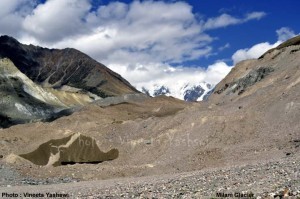 Next morning I saw magnificent view of Nanda Devi and I set out to the Nanda Devi East Base Camp (4297 mt.). It was very tough ascend. Trail became steeper and narrower. When I saw glimpse of Nanda Devi twin peaks I walked fast but I was struggling. Here I saw Rhododendrons bushes and Bhojpatra trees. In ancient time, people wrote letter on Bhojpatra (Himalayan Birch) sheets. From Base Camp, I saw full view of Nanda Devi. I stand here and forgot everything. I utterly fascinated by the magic of goddess Nanda. After spent terrific time, I turned back…
Next morning I saw magnificent view of Nanda Devi and I set out to the Nanda Devi East Base Camp (4297 mt.). It was very tough ascend. Trail became steeper and narrower. When I saw glimpse of Nanda Devi twin peaks I walked fast but I was struggling. Here I saw Rhododendrons bushes and Bhojpatra trees. In ancient time, people wrote letter on Bhojpatra (Himalayan Birch) sheets. From Base Camp, I saw full view of Nanda Devi. I stand here and forgot everything. I utterly fascinated by the magic of goddess Nanda. After spent terrific time, I turned back…
About the Author: I am Vineeta Yashswi from India. I love photography, travel and trekking. Follow me on my blog, My Nomadic Experience.
The post India: Trek For Milam Glacier appeared first on We Said Go Travel.
We Said Go Travel
We Said Go Travel is a global community of over sixteen hundred writers with articles from every continent.
Stories are shared with photos and video from a perspective of the transformative power of travel. We Said Go Travel has hosted live and online events as well as travel writing contests around the world. ...more
- Lisa Niver's profile
- 57 followers


